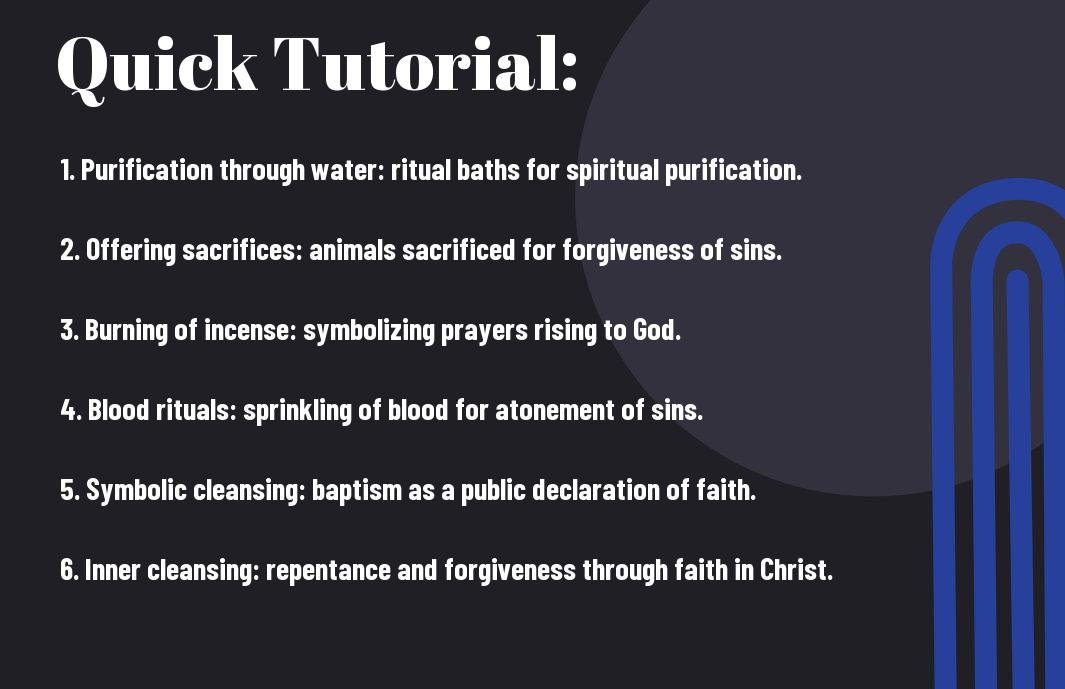Types of Cleansing in the Bible – Purification Rituals and Symbolism
- Home
- Types of Cleansing in the Bible – Purification Rituals and Symbolism

Types of Cleansing in the Bible – Purification Rituals and Symbolism
Exegesis of the Bible reveals that cleansing and purification play a crucial role in the biblical narrative. From the Levitical laws to the sprinkling of blood for atonement, the Bible is rich with symbolic acts of cleansing. In this tutorial, I will delve into the various types of cleansing found in the Bible, examining their purification rituals and the symbolism behind them. Understanding these cleansing rituals is essential for gaining a deeper insight into the spiritual significance and symbolic meaning found in the pages of the Bible. By the end of this tutorial, you will have a comprehensive understanding of the types of cleansing in the Bible and their spiritual significance for believers.
Key Takeaways:
- Purification rituals: The Bible mentions various purification rituals such as bathing in water, sprinkling with blood, and burning incense as a means of spiritual and physical cleansing.
- Spiritual symbolism: Cleansing in the Bible is often used as a symbol of spiritual purity, forgiveness, and renewal, representing the removal of sin and the restoration of a person’s relationship with God.
- Moral cleansing: The concept of cleansing in the Bible also extends to the purification of one’s moral character, emphasizing the need for repentance and inner transformation.
- Symbolic acts: Some cleansing rituals in the Bible, such as the washing of feet or the anointing with oil, serve as symbolic acts that carry deeper spiritual significance beyond their physical nature.
- Continued relevance: The types of cleansing and purification found in the Bible continue to hold spiritual and moral significance for many believers today, shaping their understanding of personal purity and spiritual restoration.
The Cleansing in the Bible
The concept of cleansing in the Bible is a significant and recurring theme that represents the process of purification, repentance, and restoration. Throughout the scriptures, various methods and rituals are detailed to cleanse individuals, communities, and objects. The act of cleansing holds deep spiritual and symbolic meanings, which are essential components of the Christian faith.
Purification Rituals
In the Bible, purification rituals were essential for maintaining spiritual and physical cleanliness. These rituals often involved the use of water, blood, and specific practices to purify individuals or objects. For example, the Jewish tradition included rituals such as the washing of hands before meals, immersion in the mikveh (ritual bath), and the sprinkling of blood for atonement. The meticulous adherence to these rituals was believed to cleanse individuals from sin and impurities, symbolizing a renewal of the soul and the restoration of relationship with God.
Symbolism
Biblical cleansing also carries powerful symbolic meanings that extend beyond the physical act. Water, for instance, is often associated with cleansing and restoration throughout the Bible. The act of baptism, involving immersion in water, symbolizes the washing away of sins and the emergence of a new life in Christ. Additionally, the imagery of fire is used to symbolize purification and refining, burning away impurities to bring forth something new and sharpened. These symbolic representations highlight the spiritual transformation and renewal that cleansing brings about in the lives of believers.
Types of Cleansing
Assuming we are talking about the types of cleansing mentioned in the Bible, it is important to note that there are different forms of cleansing, each with its own significance and purpose. The Bible talks about various forms of cleansing, including physical, spiritual, and moral cleansing. Each type of cleansing serves a different purpose and is symbolic in its own way.
| Physical Cleansing | |
| Spiritual Cleansing | |
| Moral Cleansing |
Physical Cleansing
Physical cleansing in the Bible often involves the act of ritual washing or bathing to purify oneself from uncleanness. This could include washing hands before participating in religious ceremonies or bathing after coming into contact with something considered unclean. It is a way to maintain physical purity and cleanliness in accordance with Biblical teachings.
Spiritual Cleansing
Spiritual cleansing in the Bible involves seeking forgiveness and purification from sin. This type of cleansing is more about the inner spiritual state rather than physical cleanliness. It often involves repentance and turning away from sinful behavior, seeking renewal and restoration in one’s relationship with God.
Moral Cleansing
Moral cleansing refers to the process of purifying one’s morals and ethical behavior. This could involve making amends for past wrongdoings, seeking reconciliation with others, and striving to live a righteous and upright life. It is about purging oneself from immoral behavior and aligning with God’s standards of morality.
Examples of Cleansing in the Bible
Your understanding of cleansing in the Bible would not be complete without exploring some of the key examples of purification rituals and symbolism found throughout the scriptures. These examples not only provide us with insight into the significance of cleansing, but also offer valuable lessons on how we can apply these principles in our own lives.
The Ritual of Baptism
One prominent example of cleansing in the Bible is the ritual of baptism. Baptism is a symbolic act of purification, representing the cleansing of sin and the believer’s identification with Christ’s death, burial, and resurrection. It serves as a public declaration of one’s faith and commitment to following Christ. Baptism is not merely a physical act of immersion in water, but a spiritual cleansing that marks the beginning of a new life in Christ. Through baptism, believers experience a profound spiritual cleansing as they are united with the death and resurrection of Jesus, symbolizing the washing away of their sins and the beginning of a new life in Him.
The Cleansing of the Temple
Another significant example of cleansing in the Bible is the account of Jesus cleansing the temple. This event took place when Jesus overturned the tables of the money changers and drove out those who were buying and selling within the temple courts. This act of cleansing was a powerful demonstration of Jesus’ authority and his zeal for the purity and sanctity of God’s house. It was a bold and confrontational gesture that emphasized the importance of honoring God in our worship and removing anything that defiles the sacred space of His presence. This cleansing served as a reminder of the need for spiritual purity and reverence in our worship, and it challenged the religious authorities to uphold the true essence of faith and devotion to God.

Conclusion
Ultimately, the types of cleansing in the Bible serve as important rituals and symbols for purification and sanctification. From the hygienic cleansing of the body to the spiritual cleansing of the soul, these practices remind us of the importance of holiness and righteousness in our lives. By understanding the biblical significance of cleansing, you can apply these principles to your own spiritual journey and strive for a deeper connection with God. Whether through baptism, ritual washing, or the symbolic cleansing of sin, these practices ultimately point us towards a life of spiritual purity and devotion.
Types of Cleansing in the Bible – Purification Rituals and Symbolism FAQ
Q: What are the different types of cleansing rituals mentioned in the Bible?
A: The Bible mentions several types of cleansing rituals, including washing with water, anointing with oil, and animal sacrifices for atonement of sins.
Q: What is the significance of cleansing in the Bible?
A: Cleansing in the Bible symbolizes purification and spiritual renewal. It represents the removal of sin and impurity, and the restoration of a person’s relationship with God.
Q: How were people cleansed in the Old Testament?
A: In the Old Testament, people were often cleansed through rituals such as bathing in water, sprinkling with blood, or offering sacrifices. These acts were seen as necessary for maintaining purity and holiness before God.
Q: What is the role of Jesus in the concept of cleansing in the New Testament?
A: In the New Testament, Jesus is often associated with the ultimate cleansing and atonement for sin. His sacrificial death is seen as the means by which believers can be cleansed from their sins and restored to a right relationship with God.
Q: How does the concept of cleansing apply to modern-day Christian practices?
A: In modern-day Christian practices, cleansing is often symbolized through baptism, the act of confessing and repenting of sins, and seeking forgiveness from God. It is also seen as an ongoing process of spiritual growth and purification.
- Share
Mark Twain
Mark Twain stands at the helm of Create More Flow, infusing every sentence with the wisdom of his 15-year expeience through the seas of SEO and content creation. A former BBC Writer, Mark has a knack for weaving simplicity and clarity into a tapestry of engaging narratives. In the realm of content, he is both a guardian and a guide, helping words find their flow and stories find their homes in the hearts of readers. Mark's approach is grounded in the belief that the best content feels like a chat with an old friend: warm, inviting, and always memorable. Let Mark's expertise light up your website with content that's as friendly to Google as it is to your audience. Each word is chosen with care, each sentence crafted with skill - all to give your message the human touch that both readers and search engines love.
